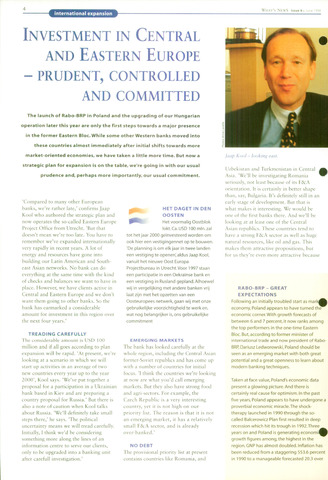Investment in Central
AND EASTERN EUROPE
- PRUDENT, CONTROLLED
AND COMMITTED
international expansion
What's NewS Issue 6 June 1996
The launch of Rabo-BRP in Poland and the upgrading of our Hungarian
operation later this year are only the first steps towards a major presence
in the former Eastern Bloc. While some other Western banks moved into
these countries almost immediately after initial shifts towards more
market-oriented economies, we have taken a little more time. But now a
strategie plan for expansion is on the table, we're going in with our usual
prudence and, perhaps more importantly, our usual commitment.
'Compared to many other European
banks, we're rather late,' confirms Jaap
Kool who authored the strategie plan and
now operates the so-called Eastern Europe
Project Office from Utrecht. 'But that
doesn't mean we're too late. You have to
remember we've expanded internationally
very rapidly in recent years. A lot of
energy and resources have gone into
building our Latin American and South-
east Asian networks. No bank can do
everything at the same time with the kind
of checks and balances we want to have in
place. However, we have clients active in
Central and Eastern Europe and we don't
want them going to other banks. So the
bank has earmarked a considerable
amount for investment in this region over
the next four years.'
TREADING CAREFULLY
The considerable amount is USD 100
million and if all goes according to plan
expansion will be rapid. 'At present, we're
looking at a scenario in which we will
start up activities in an average of two
new countries every year up to the year
2000', Kool says. 'We've put together a
proposal for a participation in a Ukrainian
bank based in Kiev and are preparing a
country proposal for Russia.' But there is
also a note of caution when Kool talks
about Russia. 'We'11 definitely take small
steps there,' he says. 'The political
uncertainty means we will tread carefully.
Initially, I think we'd be considering
something more along the lines of an
information centre to serve our clients,
only to be upgraded into a banking unit
after carefull investigation.'
HET DAGET IN DEN
OOSTEN
Het voormalig Oostblok
lokt.Ca. USD 100 min.zal
tot het jaar 2000 geïnvesteerd worden om
ook hier een vestigingennet op te bouwen.
'De planning is om elk jaar in twee landen
een vestiging te openen', aldus Jaap Kool,
vanuit het nieuwe Oost Europa
Projectbureau in Utrecht.Voor 1997 staan
een participatie in een Oekraïnse banken
een vestiging in Rusland gepland. Alhoewel
wij in vergelijking met andere banken vrij
laat zijn met het opzetten van een
Oosteuropees netwerk, gaan wij met onze
gebruikelijke voorzichtigheid te werk en,
wat nog belangrijker is, ons gebruikelijke
commitment
EMERGING MARKETS
The bank has looked carefully at the
whole region, including the Central Asian
former-Soviet republics and has come up
with a number of countries for initial
focus. 'I think the countries we're looking
at now are what you'd call emerging
markets. But they also have strong food
and agri-sectors. For example, the
Czech Republic is a very interesting
country, yet it is not high on our
priority list. The reason is that it is not
an emerging market, it has a relatively
small F&A sector, and is already
over-banked.'
NO DEBT
The provisional priority list at present
contains countries like Romania, and
Jaap Kool - looking east.
Uzbekistan and Turkmenistan in Central A
Asia. 'We'11 be investigating Romania
seriously, not least because of its F&A
orientation. It is certainly in better shape
than, say, Bulgaria. It's definitely still in an
early stage of development. But that is
what makes it interesting. We would be
one of the first banks there. And we'11 be
looking at at least one of the Central
Asian republics. These countries tend to
have a strong F&A sector as well as huge
natural resources, like oil and gas. This
makes them attractive propositions, but
for us they're even more attractive because
RABO-BRP - GREAT
EXPECTATIONS
Following an initially troubled start as mark^^
economy, Poland appears to have turned the
economie corner. With growth forecasts of
between 6 and 7 percent, it now ranks among
the top performers in the one-time Eastern
Bloc. But, according to former minister of
international trade and now president of Rabo-
BRP, Dariusz Ledworowski, Poland should be
seen as an emerging market with both great
potential and a great openness to learn about
modern banking techniques.
Taken at face value, Poland's economie data
present a glowing picture. And there is
certainly real cause for optimism. In the past
five years, Poland appears to have undergone a
proverbial economie miracle.The shock-
therapy launched in 1990 through the so-
called Balcerowicz Plan first resulted in deep
recession which hit itstrough in 1992.Three
years on and Poland is generating economi^B
growth figures among, the highest in the
region.GNP has almost doubled. Inflation has
been reduced from a staggering 553.6 percent
in 1990 to a manageable forecasted 20.3 over

